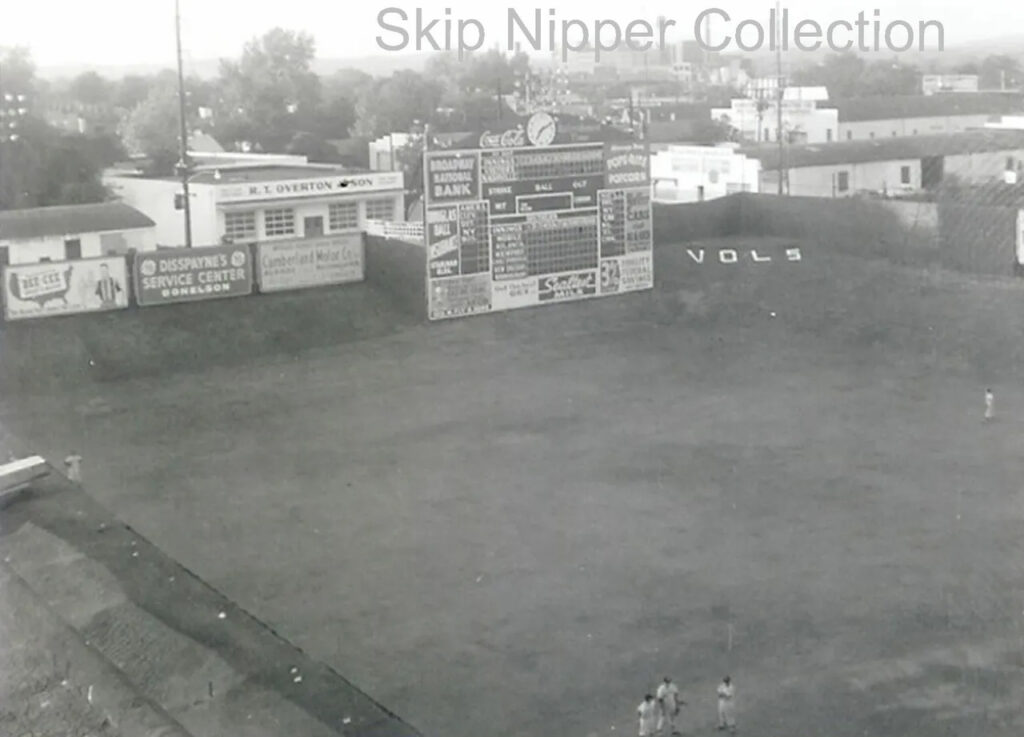
The original name of Nashville’s historic ballpark, Sulphur Dell, is attributed to Grantland Rice who wrote in his Nashville Tennessean column in 1908 “…will be known as Sulphur Spring Dell, and not Sulphur Spring Bottom, as of yore.”
Rice immortalized the name in rhyme which sealed the name that fans (Rice called them “bugs”) adopted for the ages. The poem expressed the significance of having a stadium ready in time for Opening Day, too:
In Sulphur Dell
There as a sound of revelry by day
In Sulphur Dell with axes swinging free –
And every fan there passed, yelled “Hip-Hooray –
Lay on McDuff, and give one punch for me.
And from afar the echo rolled in glee –
“The Nashville grandstand’s being torn away.”
Sweet are the songs which Madame Calve sings
But not so sweet as that of falling axe
In Sulphur Dell where every echo rings
With timbers falling under mighty whacks
Keep up the good work – break your blooming backs’
“Keep up the good work – break your blooming necks
We’ll give a cheer each time the axlet swings.
This was not the first instance of bringing the ballpark up to standards for the baseball season. In March of 1885 as Nashville’s foray into the professional realm of league play came into existence, it was reported that an extra force of workmen was put to work on the grounds of Athletic Park (the original sobriquet of the ballpark), grading the field and laying off the diamond before the Southern League season would begin a few weeks later.
That did not stop games from being played: on March 30 and 31, Nashville hosted a team from Indianapolis, and on April 1 over 1,500 spectators watched Nashville beat the Clevelands 15-7 and 3-2 a day later. On May 6 the Nashville club begins its home season with Chattanooga and 2,000 fans are in attendance as Nashville loses 9-7.
In 1897 the old bleachers on the east side were torn away and in their place were erected a large number of seats “such as are used in curcuses (sic).”
In 1901 Nashville’s baseball team entered the newly-formed Southern Association and upgrades to the ballpark took place again, although as late as the first of April there were reports that dressing rooms for the players had yet to be constructed. Seating capacity was being increased to 2,500 with 1,000 seats available in the grandstand.
Newt Fisher, owner-manager of the Nashville club, announced on October 1, 1903 that the grandstand would be increased by 500 seats. Fisher was beginning his plans well in advance after what had been a profitable year for him. Fisher had made $10,000 over the course of the season.
When the ballpark was turned around for the 1927 season, the old grandstand was demolished and a new steel-and-concrete design was chosen to replace it. Winter weather and rain interrupted the process more than once, and in February, the contractor was offered a bonus of $5,000.00 to complete the structure for the March exhibition season.
Once again, games were played no matter the conditions of the grandstand. With the playing field in optimum shape and workmen continuing their work, on March 25 the first contest is held in the new ‘turned-around’ ballpark. It was an exhibition game played between the Nashville Vols and Minneapolis Millers, the Millers winning 5-3 as the visiting team’s right-fielder Dick Loftus hits the first home run in the new park.
It would be a while before more upgrades would take place. A new scoreboard was added in left-center field, but that would be the extent of new construction until a few cosmetic revamps would happen. When fans arrived on Opening Day April 17, 1951, they saw a remodeled facade, new turnstiles, brick walls, wider exists and other improvements. Unchanged were the “dumps” in the outfield and the short right field fence.
On Easter Sunday, April 1, 1956 between 2-5 PM, the Nashville Vols management held an open house for the “renovated” ballpark. The playing field of the ancient park was altered somewhat by the smoothing out of the right field “porch”. Additional improvements consisted of a new coat of green paint for the stadium seats, except for the reserved seats section which were painted orange.
For the 1958 season a left-field bleacher section was torn down and a weather-damaged fence replaced, but no additional changes were made to Sulphur Dell during the demise of the facility and baseball in Nashville.
After selling light fixtures, stadium seats, and other items that had some remaining value, on April 16, 1969 the ballpark was demolished and filled in; the remains of the recent demolition of the Andrew Jackson Hotel (to make room for the Tennessee Performing Arts Center) was deposited on the site.
As with most Opening Days, the “bugs” will have to trust those who “break their blooming backs” to have the field in shape and the ballpark in order. Fans will cheer them on with a hearty “Hip-Hooray!”
© 2019 by Skip Nipper. All Rights Reserved.



